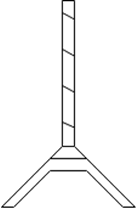This set of Surveying Multiple Choice Questions & Answers (MCQs) focuses on “Triangulation – Signals and Towers”.
1. A structure erected over a station can be determined as___________
a) Signal
b) Tower
c) Instrument station
d) Satellite station
View Answer
Explanation: A tower can be designated as a structure which is erected over a station, for supporting the instrument. Most probably it can be seen when the station has to be elevated.
2. The amount of elevation depends on which of the following characteristics?
a) Instrument used
b) Gradient
c) Slope level
d) Characteristics of terrain
View Answer
Explanation: The elevation which is provided to the station will depend upon the characteristic of the terrain the base line has to be setup. Both the stations are to be elevation enough so that they are inter visible to each other.
3. Which type of structure (tower) can be used for small heights?
a) Masonry structure
b) Wooden structure
c) Steel structure
d) Timber structure
View Answer
Explanation: A tower is generally made of masonry, timber and steel. For small heights, masonry structure is adoptable, which makes them economical for the range of work they do.
4. What is the height of a Bilby tower?
a) 10 m
b) 20 m
c) 30 m
d) 50 m
View Answer
Explanation: Bilby tower is one of the types of tower, which is named after the inventor, which can uplift the observer as well as the lamp to a height of 30 m minimum and to a maximum of 40 m. Manual power is needed for the upliftment.
5. Which of the following determines the exact position of the observed station?
a) Signal
b) Tower
c) Theodolite
d) Chain
View Answer
Explanation: A signal can determine the exact position of the station with its functionality. The classifications are done so that it can be used within the specified ranges.
6. Which of the following is not a classification of signal?
a) Sun signal
b) Night signal
c) Daylight signal
d) Polarised signal
View Answer
Explanation: A signal is divided into certain categories so that it can serve within the specified range. The classifications include day light signal, night signal, sun signal, which are free from the phase.
7. A signal must contain phase.
a) True
b) False
View Answer
Explanation: A signal is a device which is capable of determining the exact location of the station. In order to exhibit this property, it must be free from phase. But it can be allowed to have some phase in it.
8. Opaque signal is having a range of ___________
a) 50 km
b) 40 km
c) 30 km
d) 80 km
View Answer
Explanation: Day light or opaque signals consists of various forms in it. They are eligible to sight up to a distance of 30 km after which the grip on sight will be lost. For more than 30 km sighting, other methods can be employed.
9. In which of the following cases, a pole signal is used?
a) Non-Luminous signal
b) Luminous signal
c) Night signal
d) Polarised signal
View Answer
Explanation: In day light signal, if the measurement has to be done within 6 km range then pole signal are used. Pole signal is consists of pole painted in alternate colours for easy identification. It is rested on the tripod.
10. Which among the following indicates the instrument used in Sun signals?
a) Polarised signal
b) Night signal
c) Non – Luminous signal
d) Luminous signal
View Answer
Explanation: A heliotrope is an instrument, which is used as a sun signal. It consists of a plane mirror to reflect sun’s rays. The line of sight can be telescopic with an aperture consisting cross hairs.
11. The figure belongs to which of the following classifications?

a) Night signal
b) Luminous signals
c) Non-luminous signals
d) Sun signal
View Answer
Explanation: The figure given here will come under the classification of signal which is used in case of opaque signals which can site up to 30km. In order to have the visibility of the signal rod is placed on the stand, having alternate colors for easy identification.
12. What will be the face correction made on bright line, if the radius of the signal is given as 24m, angle with which the station points make with the sun is given as 24˚12ꞌ and the distance between the station points is given as 85m?
a) 953˚11ꞌ
b) 59˚11ꞌ
c) 359˚11ꞌ
d) 593˚11ꞌ
View Answer
Explanation: The determination of the phase correction on a bright line can be done by using the formula,
β = 206265*r*cos (α/2) / D. On substitution, we get
β = 206265*2*cos (24˚12ꞌ/2) / 85
β = 593˚11ꞌ.
Sanfoundry Global Education & Learning Series – Surveying.
To practice all areas of Surveying, here is complete set of 1000+ Multiple Choice Questions and Answers.
If you find a mistake in question / option / answer, kindly take a screenshot and email to [email protected]
- Apply for Civil Engineering Internship
- Check Civil Engineering Books
- Practice Civil Engineering MCQs
- Check Surveying Books
